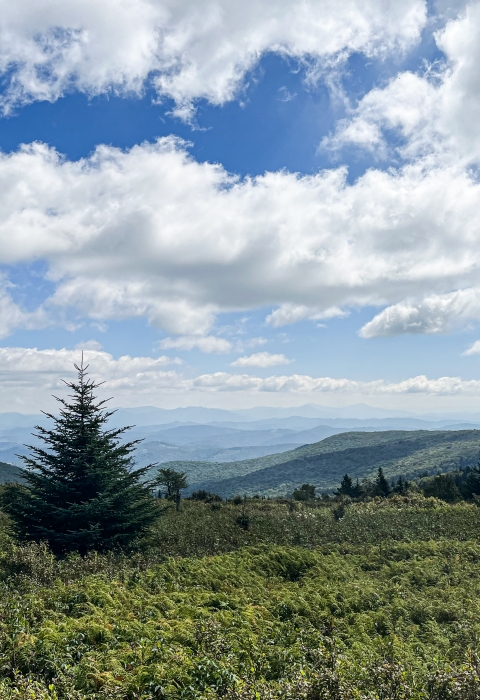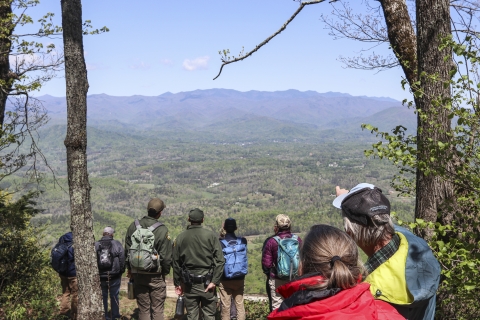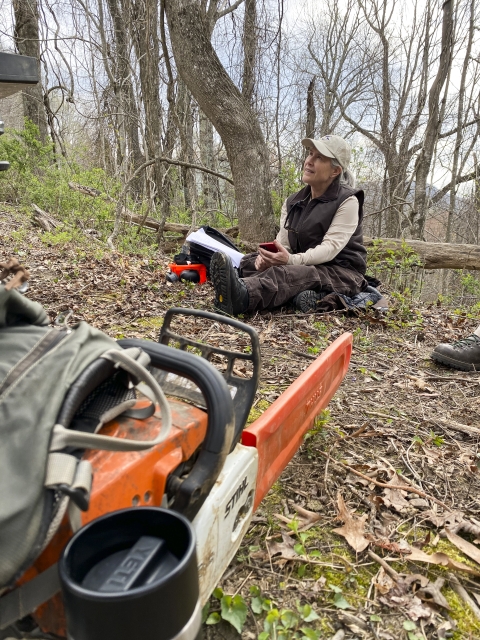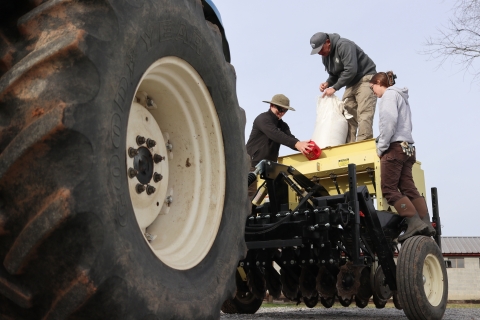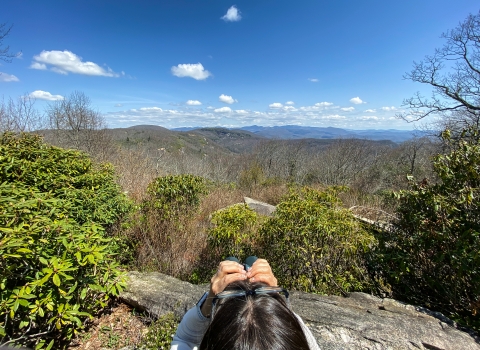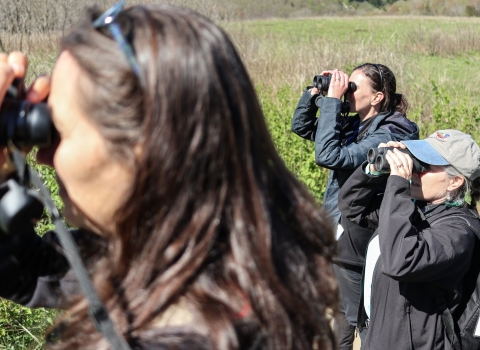September 26
Speaking about pollinator conservation - Asheville Field Office biologist Bryan Tompkins spoke to approximately 30 people on pollinator conservation at an event sponsored by the Highlands-Cashiers Land Trust. The presentation was paired with a public forum and discussion about a public space converted to pollinator habitat.
Red spruce restoration effort - Sue Cameron, Gary Peeples, and Holland Youngman, all of the Asheville Field Office, joined staff from multiple agencies and NGOs in the Black Mountains of Western North Carolina to release red spruce. The work is part of a broader effort to restore red spruce to high elevation forests. These forests are home to endangered Carolina northern flying squirrel and spruce-fir moss spider and went through tremendous upheaval during rampant industrial logging and wildlife in the early twentieth century. The work focused on creating gaps in the forest canopy that would gie existing red spruce enough light to flourish.
Yancey County students get outside - Students in western North Carolina’s Yancey County spent a day exploring the South Toe River with the help of Asheville Field Office staff Byron Hamstead, Mark Endries, Laura Fogo, and Jeff Quast. The educational event, dubbed “Toes in the Toe,” brings every fifth-grade student in the county out to the South Toe River, where they rotate through educational stations including ones that provide the chance to collect and identify fish and aquatic invertebrates. The South Toe River is home to the endangered Appalachian elktoe mussel.
September 20
Spider monitoring – The 2024 monitoring season for the endangered spruce-fir monitoring season came to a close recently, with a survey of two ten-acre plots in the backcountry of Great Smoky Mountains National Park. The monitoring effort is led by Sue Cameron of the Asheville Field Office, and for these plots she was joined by Mark Endries and Gary Peeples, also of the Asheville Field Office, and Brian Bockhahn of N.C. State Parks. The plots were the most remote yet visited in the monitoring effort, requiring a total of 18 miles of hiking and two nights in the backcountry to access and survey them.
Connecting people with nature - Fifth-grade students in Mitchell County, NC, perched on the eastern edge of the Tennessee River basin, recently spent a day exploring a stream in their community and learning about stream health. Asheville staff helped with the locally organized event by staffing a station on aquatic invertebrates where students collected the stream animals then practices using basic keys to identify what they collected. The students were in Cane Creek, a tributary to the North Toe River, which is home to the endangered Appalachian elktoe mussel.
September 13
Pigeon River Kids in the Creek – Several staff from the Asheville Field Office helped local watershed group Haywood Waterways implement the 2024 Kids in the Creek event. The annual event, now more than twenty years old, brings every 8th grade student in Haywood County out to the Pigeon River where they rotate through stations teaching them about the river and providing the opportunity to collect and identify fish and stream invertebrates. The Pigeon River is home to the endangered Appalachian elktoe and is said to get its name from flocks of passenger pigeons that once frequented the area.August 29
August 29
Rappahannock River mussels – Asheville Field Office biologist Jason Mays joined a team of approximately twenty Service staff from across the eastern United States in an intensive week of mussel surveys in Virginia’s Rappahannock River. The team focused on the little-surveyed river reach between Fredericksburg, VA downstream to where the water become brackish, helping fill in a significant data gap and finding a green floater, a mussel currently proposed for the federal threatened and endangered species list.
Listening for bats - At a point when more bats species are receiving Endangered Species Act protection, the technology to detect bats is rapidly improving. Sue Cameron, Mark Endries, Janet Mizzi, Gary Peeples, Rebekah Reid, and Holland Youngman from the Asheville Field Office spent a day sharing experiences and increasing their familiarity with the technology used to record bat calls, which are then processed by software that identifies the species recorded. The detectors were deployed at a conserved wetland in Western North Carolina and left to record several days of bat calls.
August 22
Operation Hot Llama – A llama train typically delivers supplies to LeConte Lodge, a backcountry guest lodge within Great Smoky Mountains National Park, however, recent high temperatures posed a risk to the health of the pack animals, so a longline drop from a helicopter was identified as a one-time alternative. Asheville Field Office biologist Rebekah Reid worked closely with National Park Service staff to quickly complete Endangered Species Act review of the helicopter drop, enabling the lodge to get their supplies and the llamas to get their break.
August 15
Spider search – In working through year three of a six-year monitoring effort for the endangered spruce-fir moss spider, Sue Cameron and Gary Peeples of the Asheville Field Office joined Brian Bockhahn of N.C. State Parks in a spider survey near Clingman’s Dome, the highest point in Great Smoky Mountains National Park. The three spent several hours traversing the steep terrain, turning up two of the rare spiders. The monitoring effort spearhead by Cameron with heavy on-the-ground support from Bockhahn, should provide the best picture we’ve ever had of the spider’s distribution and status.
Cataloochee Valley Bat survey – A female northern long-eared bat turned up during a recent bat survey in Great Smoky Mountain National Park, where Asheville Field Office biologist Sue Cameron assisted biologists with the NC Wildlife Resources Commission. The evening brought 14 bats of six species, and one curious, nosy female elk. Although the northern long-eared bat they found was a female, there was no indication she was reproductive.
August 8
Roan Mountain spreading avens – Endangered spreading avens, a plant only found in the highest areas of Southern Appalachia, has been the subject of an intense and long-running monitoring effort led by the National Park Service. Service biologists have assisted with the monitoring effort several times over the years, and this year Asheville Field Office biologist Rebekah Reid recently joined US Forest Service staff at Roan Mountain, on the Tennessee/North Carolina state line, to help with the monitoring effort there. Monitoring spread avens is especially challenging because it often grows on rocky outcrops requiring rappelling to access the plants.
August 1
Spider search – As part of an ongoing effort to monitor the spruce-fir moss spider – an endangered species that otherwise receives little attention and has few experts – Asheville Field Office biologist Sue Cameron recently had a banner day, finding eleven of the spiders and multiple egg sacks at a monitoring plot in North Carolina’s Black Mountains. It’s the highest number of individuals found in a single monitoring plot since Cameron started using a new monitoring regime developed at Clemson University. The spider is about the size of a pencil eraser and is only found on the highest peaks of southern Appalachia.
Commercial development review – Asheville Field Office biologist Byron Hamstead recently completed formal review under the Endangered Species Act of a commercial development in Forest City, NC. The proposed project will impact dwarf-flowered heartleaf, a threatened plant currently proposed for removal from the federal list of threatened and endangered species. The project proponents will move dwarf-flowered heartleaf plants from the project footprint, relocating them to a suitable site which they will them place under conservation easement conservation easement
A conservation easement is a voluntary legal agreement between a landowner and a government agency or qualified conservation organization that restricts the type and amount of development that may take place on a property in the future. Conservation easements aim to protect habitat for birds, fish and other wildlife by limiting residential, industrial or commercial development. Contracts may prohibit alteration of the natural topography, conversion of native grassland to cropland, drainage of wetland and establishment of game farms. Easement land remains in private ownership.
Learn more about conservation easement . The relocated plants will be monitored for five years.
July 3
Classification class – Former Asheville Field Office biologist Andrew Henderson recently helped teach the Endangered Species Act listing class at the National Conservation Training Center. Henderson has been involved in numerous listing decisions for wide-ranging mussels and has often helped teach the class. Teaching in the class was one of the last things Henderson did as a member of the Asheville Field Office staff before he transitioned to the Division of Classification and Conservation.
June 27
Millkweed donation – Plant producer Costa Farms recently donated 2800 butterfly milkweed plants for use in western North Carolina pollinator gardens. Asheville Field Office biologist Bryan Tompkins has a long-standing relationship with the Costa Farms facility outside Asheville, NC through his work as the office pollinator conservation coordinator. Tompkins was able to facilitate the donation and subsequent distribution of the plants, which will be used in a variety of pollinator conservation efforts including schoolyard pollinator gardens.
New intern – Michelle Henson recently started in the Asheville Field Office, becoming the office’s latest Pathways intern. Henson is a doctoral student at the University of Georgia, although she completed her undergraduate degree at the University of North Carolina Asheville.Henson will help the office with the latest round of five-year reviews and some upcoming species status assessments.
Pollinator celebration – As part of the 2024 pollinator week celebration, Asheville Field Office biologist spoke at The Bees’ Needs: Understanding and Supporting Pollinators Summit, hosted by Warren Wilson College and Bee City Asheville. The event was held on the Warren Wilson College campus and included a day-long line-up of speakers, culminating in a keynote speech by Dr. Stephen Buchmann, of the University of Arizona. Tompkins spoke on a local initiative he has led to bring pollinator conservation to school grounds and classrooms in Buncombe County, NC.
First aid training – Sue Cameron become the latest Asheville Field Office staff person to be certified in CPR and wilderness first aid. Training was provided by Oxbow River Snorkeling and was arranged by Asheville Field Office staff member Jeff Quast. Cameron joins seven other Asheville Field Office staff in having this dual certification.
May 30
Bumble bee class – With increasing imperilment of pollinator species, Asheville Field Office biologist Bryan Tompkins is working to get people trained on basic bumble bee survey techniques to help fill data gaps and identify places where rare bumble bees may be extant. He recently provided training to staff and volunteers of the Highlands-Cashiers Land Trust. This follows previous trainings given to staff of the U.S. Forest Services and National Park Service.
May 24
Forest Service meeting – Asheville Field Office biologist Rebekah Reid recently sat down with U.S. Forest Service staff from the National Forests of North Carolina to teach them about resources for evaluating their projects for threatened or endangered species impacts under the Endangered Species Act. She went over the Service’s online Information for Planning and Consultation ( IPaC IPaC
Information for Planning and Consultation (IPaC) is a project planning tool that streamlines the USFWS environmental review process
Learn more about IPaC ) tool which helps people evaluate their project, and she also went over some “determination keys” which provide a simple way to help project proponents determine if certain listed species may be impacted. The session came together as the Forest Service welcomes new staff and increasing numbers of wide-ranging bat species are facing Endangered Species Act protections due to losses from white-nose syndrome.
Bio-blitz – Asheville Field Office biologist Mark Endries helped biology students at the University of North Carolina – Asheville perform a bio-blitz at a nearby natural area. The blitz is an annual spring event for the students, and this year Endries not only helped them in the field, but also worked with the town of Weaverville to get them to host the event on town land that is under a conservation easement.
May 17
New pollinator garden – A student volunteer work crew from Buncombe County Early College recently turned out to install a pollinator garden of Asheville-Buncombe Technical College, which hosts the early college. Asheville Field Office biologist Bryan Tompkins arranged the garden installation with school faculty and led the students in installing it. The garden is the latest in a series of pollinator gardens Tompkins has helped install on Buncombe County school grounds.
Land conservancy presentation – Land trusts from across North Carolina recently convened at the Valle Crucis Conference Center for the 2024 North Carolina Land Trust Federation Assembly. Asheville Field Office staff member Gary Peeples dropped in on the two-day event, joining representatives from the U.S. Forest Service and National Park Service to talk about how the agencies interact with land conservancies. Area land trusts have played an integral role in protecting habitat for threatened and endangered species across Western North Carolina.
Bat detection training – With the northern long-eared bat declared endangered and a pending decision on whether tri-colored bat will be placed on the federal threatened and endangered species list, there is a pressing need for a more complete picture of where bats live on the landscape in order guide efforts to conserve them. Asheville Field Office biologist Rebekah Reid recently completed training on the use of acoustic sensors to detect bats, becoming the third biologist in the office with such training. Trained biologists can use recordings of bat calls to identify bat species in a given area, a far less labor-intensive and intrusive method than the traditional catching of bats in an extremely fine net.
May 10
School pollinator garden – Students from the Buncombe County Schools Virtual Academy recently turned out to install a pollinator garden at their school office. Asheville Field Office staff Bryan Tompkins and Jeff Quast helped install the garden, which was the culmination of work with school staff to teach the students about pollinator conservation and have them design mock-ups of the garden. This is the latest accomplishment in a pollinator conservation partnership between the Service and Buncombe County Schools, which was spearheaded by Tompkins.
Spruce monitoring – The Service has long been involved in red spruce restoration in Southern Appalachia to expand habitat for the endangered Carolina northern flying squirrel and spruce-fir moss spider. As the restoration effort has ramped up, various facets have come on-line, from nursery production of new spruce trees to handling environmental compliance for work on public plans. Asheville Field Office biologist Sue Cameron recently visited the Black Mountains of North Carolina to meet with Dr. Jay Raymond of West Virginia University, Institute of Technology, to discuss and start setting up long-term monitoring plots to gauge the ecological impact of red spruce in Southern Appalachia.
Sicklefin redhorse – The sicklefin redhorse, a fish found only in far western North Carolina and a sliver of North Georgia, has been the focus of concentrated, and successful, conservation efforts for several years, with the spring 2024 field season just wrapping up. Each year a team of state, federal, tribal, and private biologists come out during the fish’s spawning run to monitor fish numbers and movement and, if needed, collect and fertilize eggs for captive propagation. Jay Mays from the Asheville Field Office and staff from Warm Springs National Fish Hatchery assisted with this year’s effort, during which thousands of eggs were collected and taken back to the hatchery for hatching and rearing with an eye to future stocking.
May 3
Fish translocation – Western North Carolina’s French Broad River is the site of recovering mussel populations, as the endangered Appalachian elktoe and other mussels recolonize former habitat thanks to improved water quality. Asheville field office staff member Jeff Quast recently joined biologists from the N.C. Wildlife Resources Commission to assist that effort by helping with a long-term effort to translocate mussel host fishes – many of our native mussels spend part of their life cycle attached to fish - from the downstream portion of the river, past dams and into the upstream portion of the river.
Electrofishing course – An overhauled, in-person electrofishing course recently debuted at the Service’s National Conservation Training Center. Asheville Field Office biologist Jason Mays helped develop and teach the class, which has a heightened emphasis on safety. Electrofishing is a field technique in which an electrical current is passed through water to temporarily stun fish, allowing biologists to easily collect and handle the animals for activities like collecting data or attaching tags.
April 26
Hickorynut Mountain – The opportunity to permanently conserve more than 12,000 acres in western North Carolina is on the table. Staff from the Asheville Field Office, Piedmont National Wildlife Refuge, and the regional refuge program joined staff from N.C. State Parks, N.C. Wildlife Resources Commission, and the Foothills Conservancy in a visit to the site. The visit kicked of what will likely be a long series of conversations among the organizations about developing and implementing an acquisition and management strategy for the property, currently owned by tech entrepreneur and conservationist Tim Sweeney.
Goldenwing warbler habitat – The highway between the communities of Robbinsville and Stecoah, in far western North Carolina, climbs up and over a ridgeline, crosses the Appalachian Trail, and passes through golden-winged warbler habitat. As part of an expansion and improvement effort for the road, the N.C. Department of Transportation agreed to set aside patches of habitat for the warbler, currently under consideration for Endangered Species Act protection. Asheville Field Office biologist Holland Youngman recently joined staff from the NCDOT and North Carolina Wildlife Resources Commission for a day of planting one of the habitat patches near the highway, bringing to fruition a commitment made by the NCDOT during environmental review for the project.
April 19
UNCA class – Asheville Field Office biologist Sue Cameron recently spoke to an environmental restoration class at the University of North Carolina Asheville. Cameron has been heavily involved in efforts to restore red spruce to the high-elevation forests of southern Appalachia, where is it a key habitat component for the endangered Carolina northern flying squirrel. She has become a regular guest speaker in the class, “Environmental Restoration,” which is taught by Dr. David Gillette.
April 12
Chainsaw class – With field season gearing up, staff from the Asheville Field Office updated their training on chainsaw use and safety. Byron Hamstead, Laura Fogo, Mark Endries, and Andrew Henderson joined Jason Mays, a chainsaw instructor, for the day-long, field-based training. Asheville Field Office staff use chainsaws largely to assist with vegetation management at southern Appalachian bogs, including at Mountain Bogs National Wildlife Refuge, where imperiled species of plants can be shaded out by common trees such as maple and alder.
Office clean-up – With the arrival of spring comes the ritual of spring cleaning. Asheville Field Office staff came together in what has become an annual community ritual – cleaning and organizing the office’s storage areas which house everything from chainsaws to wetsuits. The morning of cleaning was followed by an office pot-luck lunch.
Arboretum visit – Janet Mizzi, Dr. Natali Ramirez-Bullon, and Gary Peeples of the Asheville Field Office recently visited the North Carolina Arboretum to begin laying the groundwork for future collaboration. They spoke with several members of the horticulture and landscape staff, and toured facilities used for seed storage, plant propagation, and grow-out. Western North Carolina is home to numerous federally threatened and endangered plants, found in habitats as diverse as rocky mountain peaks to Southern Appalachian bogs.
Nantahala Mountains BO – Formal review of a forest management project on North Carolina’s Nantahala National Forest was recently concluded by Rebekah Reid of the Asheville Field Office. The Nantahala Mountains Project is a multi-faceted effort that includes increasing early successional habitat, reestablishing mixed hardwood forests, improving fish passage fish passage
Fish passage is the ability of fish or other aquatic species to move freely throughout their life to find food, reproduce, and complete their natural migration cycles. Millions of barriers to fish passage across the country are fragmenting habitat and leading to species declines. The U.S. Fish and Wildlife Service's National Fish Passage Program is working to reconnect watersheds to benefit both wildlife and people.
Learn more about fish passage , and improving parking areas. The Forest Service incorporated several project features aimed at minimizing impact to federally protected bats during the project, including ensuring snags, or dead trees, remain in the area as roosting habitat for bats and committing to consult further with the Service should any work become slated for areas around key bat habitat such as maternity roosts which are used by bats for birthing and raising young.
April 5
Learning about pollinators – More than 200 students at Cane Creek Middle School, in Buncombe County, N.C. attended presentations on pollinator conservation given by Asheville Field Office biologist Bryan Tompkins. The presentations are part of a broader partnership Tompkins has spearheaded with Buncombe County and surrounding county schools that has had him providing pollinator conservation presentations to classes and facilitating the installation of schoolyard pollinator gardens. Educators with the school system have developed a kindergarten - 12th grade pollinator-centric curriculum to accompany the presentations and garden installations.
March 29
Prescribed fire review - Prescribed fire is a key tool in land management across much of the Southeast. Asheville Field Office biologist Rebekah Reid recently completed Endangered Species Act review of 14 prescribed fire projects, covering nearly 11,000 acres, that are slated for the National Forests of Western North Carolina, representing the majority of the 2024 prescribed fire workload on these forests. This review entails identifying impacts to threatened and endangered species and critical habitat, and working to minimize or eliminate those impacts.
March 22
Swamp pink genetics – Swamp pink is a federally threatened wetland plant occurring from Georgia to New Jersey. Asheville Field Office biologist Dr. Natali Ramirez-Bullon joined U.S. Forest Service staff and Appalachian State graduate student Kate Loughran as Loughran gathered tissue samples from swamp pink plants on Pisgah National Forest. The sample will contribute to her work conducting a genetic diversity analysis of swamp pink populations across North Carolina.
Brown bag lunch – The Asheville Field Office recently completed their winter, internal, brown bag lunch series with a presentation by Gary Peeples on the history of Mountain Bogs National Wildlife Refuge, a refuge the Asheville office played a large role in establishing. The series was established to build office community during an era of telework and to share an understanding of the breadth of the office’s work among all staff members. This presentation was the fifth in the series, which included talks on pollinator conservation, the consultation process, species listing and SSAs, and plant recovery.
Pollinator presentations – Asheville biologist Bryan Tompkins recently presented on pollinator conservation to several classes at T.C. Roberson High School and Buncombe County Early College in Buncombe County, N.C. Tompkins has spoken to over 300 students in the past two weeks. The presentations are part of a broader partnership Tompkins has spearheaded with Buncombe County and surrounding county schools that has had him providing pollinator conservation presentations to classes and facilitating the installation of schoolyard pollinator gardens. Educators with the school system have developed a kindergarten - 12th grade pollinator-centric curriculum to accompany the presentations and garden installations.
March 15
Office first aid class – With field season on the cusp of ramping up, staff from the Asheville Field Office recently completed CPR/wilderness first aid training. Byron Hamstead, Mark Endries, Jay Mays, Laura Fogo, Jeff Quast, Karla Quast, and Andrew Hamstead all completed the class. The office took advantage of the staff gathering to have an early Pi Day celebration with a pie-centric pot-luck lunch.
Bog Learning Network – Southern Appalachian bogs are a suite of rare wetland types that are home to several species protected by the Endangered Species Act. The Bog Learning Network was created more than a decade ago to bring together conservationists working in these wetlands. This year’s meeting was recently held on the campus of UNC-Asheville, and included Asheville Field Office biologists Dr. Natali Ramirez-Bullon speaking on pitcher plant hybridization and Sue Cameron speaking on the process for considering the bog turtle’s southern population for additional Endangered Species Act protection.
March 8
National Forest site visit –Asheville Field Office biologists Rebekah Reid and Sue Cameron joined biologists and silviculturalists from the U.S. Forest Service to visit sites on Nantahala National Forest and discuss how to minimize impacts to Federally protected bats during timber harvests. Due to white-nose syndrome, once common bats have become imperiled, leading to discussions about how federal agencies can meet their Endangered Species Act obligations to these species. These bats are often habitat generalists that can be found across wide swaths of the landscape, as opposed to small areas of specialized habitat.
Advancing red spruce restoration – Red spruce is a key habitat component for northern flying squirrels, including the endangered Carolina northern flying squirrel. Work to restore red spruce in the central and southern Appalachians has long been underway but is poised to accelerate with the potential for additional restoration work on national forests. To help plan for that potential work, Asheville Field Office biologists Rebekah Reid and Sue Cameron participated in a meeting of a red spruce technical advisory group, helping define how red spruce restoration on national forests might be accomplished so the U.S. Forest Service can appropriately comply with environmental regulations.
Mollusk conservationists come together – The Freshwater Mollusk Conservation Society (FMSCS) is the world’s preeminent professional organization focused on the conservation of freshwater mollusks like mussels and snails, and the southeastern United States is a global epicenter of freshwater mussel diversity. Asheville Field Office biologist Andrew Henderson attended the 2024 FMCS biennial workshop, held this year in Auburn, AL. The biennial workshop is focused on bringing researchers and managers together to help ensure the data that managers need to make good decisions about mussel management exists and is accessible.
February 22
Mills River pollinator planting – A focal point of the community of Mills River, N.C. is the 48-acre Mills River Park, which nods to the natural heritage of the area with river access for paddling and snorkeling and a recently planted 15-acre pollinator meadow. The field will be a mixture of wildflowers and native grasses, complimenting a previously installed pollinator garden, and is the culmination of a lot of teamwork at the local, state, and federal levels. The town of Mills River provided the land – Mills River Park – and a vision for the park that incorporated the pollinator meadow; the North Carolina Wildlife Resources Commission provided the equipment – a tractor and seed drill that simultaneously cuts the soil surface and drops seed into the cut - and staff to operate it; and the Service provided technical support in planning the meadow and funding for seeds through its Partners for Fish and Wildlife program.
Southeast Bat Diversity Network meeting – Asheville Field Office biologist Sue Cameron recently attended the 2024 Annual Southeast Bat Diversity Network Meeting and Colloquium on the Conservation of Mammals in the Southeastern United State, held in Hilton Head, S.C. with more than 200 participants. Cameron serves as the secretary for the bat diversity network and is the bat expert for the Asheville office.
Review of the Woodfin Wave – The Woodfin Wave is a proposed hardscaped whitewater paddling park on the French Broad River, in Woodfin, N.C. Asheville Field Office biologist Byron Hamstead recently completed formal review of the project which would occur in the habitat of the endangered Appalachian elktoe mussel. The project requires a permit from the U.S. Army Corps of Engineers, which incorporated numerous conservation measures related to sediment and erosion control, how in-stream construction will be conducted, and minimizing impacts to bats.
February 15
Bat bridge exclusion – During warmer months, endangered gray bats are known to roost on a McDowell County, N.C. road bridge currently slated for maintenance by the N.C. Department of Transportation. To keep those bats out of harm’s way should they return to the bridge while maintenance is underway, Asheville Field Office biologist Holland Youngman recently worked with NCDOT staff and a state of North Carolina biologist to temporarily seal the joints where the bats roost, preventing the endangered bats from crawling into the bridge’s nooks and crannies while maintenance work is underway. When maintenance work is complete, the sealing will be removed, enabling the bats to roost on the bridge once again.
February 8
Electrofishing safety – Electrofishing is a field technique in which an electrical current is passed through water to temporarily stun fish, allowing biologists to easily collect and handle the animals for activities like collecting data or attaching tags. The Service is currently revising safety protocols governing the use of electrofishing by Service biologists. Asheville Field Office biologist Jason Mays recently joined Service biologists from across the country as well as workplace safety experts to begin updating the procedures.
Swain County mine work – Swain County, N.C. is home to a pair of remote, abandoned copper mines now used by hibernating Rafinesque's big-eared, little brown, tricolored, and big brown bats. Asheville Field Office biologist Sue Cameron recently joined biologists with the N.C. Wildlife Resources Commission as they boated, rode utility vehicles, and hiked to reach the remote mines to conduct the latest bi-annual survey of hibernating bats. Results were mixed, with one mine having decreased bat numbers while the other had solid numbers.
Sicklefin redhorse meeting – Aquatic biologists recently convened in a conference room on the north side of Asheville, N.C. to review the latest research on sicklefin redhorse and chart a course for upcoming field work. The Service was represented by Jay Mays from the Asheville Field Office and Ian Paige and Michael Fulghum from Warm Springs National Fish Hatchery and they were joined by biologists from Duke Energy, the Eastern Band of Cherokee Indians, Georgia Department of Natural Resources, North Carolina Wildlife Resources Commission, and the Tennessee Valley Authority. The sicklefin redhorse was once considered for Endangered Species Act protection and has been the focus of a concerted conservation effort to get ahead of the need for such protection.
Assisting the Florida Ecological Services Office – Asheville Field Office biologist Andrew Henderson began a one-month detail as manager of the classification and recovery division in the Florida Ecological Services office a position held by Lourdes Mena, who, in turn, is currently on a detail to the Caribbean Field Office. In recent years Henderson has gained extensive listing experience, serving as the lead field biologist for eight wide-ranging freshwater mussels considered for Endangered Species Act protection.He is also an instructor for the Endangered Species Act listing course offered at the Service’s National Conservation Training Center.
Flying squirrel monitoring – Recent years have seen a significant uptick in efforts to restore red spruce on the highest peaks of southern Appalachia, an effort that builds on modeling and mapping work done by Asheville Field Office biologist Mark Endries, an expert in the analysis and use of geographic data. One of the species slated to benefit from this restoration effort is the endangered Carolina northern flying squirrel. Endries recently joined biologists with the N.C. Wildlife Resources Commission for part of their wintering monitoring of the endangered squirrel, providing a chance to step away from his computer-focused work to see the species in its habitat and assist field biologists in their effort to track squirrel populations.
February 1, 2024
Avery County mine bat survey – A former iron mine in Avery County, N.C. was once one of the most important bat hibernacula in North Carolina, though the number of bats hibernating in the mine has dropped dramatically since the arrival of white-nose syndrome. Asheville Field Office biologist Sue Cameron recently joined state biologists to assist with their bi-annual survey of bats in the mine. Now under permanent conservation ownership, the mine is home to little brown, big brown, and tricolored bats.
January 25, 2024
Roan Mountain Stewardship Committee - Roan Mountain is one of the signature natural areas of Southern Appalachia as it is one of the highest peaks east of the Mississippi, home to six threatened or endangered species, traversed by the Appalachian Trail and the site of grass-covered peaks that draw in vista-seekers. As such, management of the area involves several key stakeholders, organized as the Roan Mountain Stewardship Committee. Earlier this year, the committee held its first in-person meeting since the beginning of the COVID pandemic, with the Service represented by Asheville Field Office biologist Sue Cameron.
Tennessee imperiled mussels meeting –Tennessee is a state with a rich diversity of aquatic life, including a tremendous number of freshwater mussel species. Each year, aquatic biologists come together for the Tennessee Endangered Mollusk Committee meeting, a long-standing forum for biologists to come together to share experiences and knowledge gained over the previous year, and to work together to plan the upcoming year’s work. This year’s meeting was attended by Service biologists from Kentucky, North Carolina, Tennessee, and Virginia, reflective of the fact that many imperiled mussels found in Tennessee have ranges that extend beyond the state’s borders.
January 18
Forest Service prescribed burn prescribed burn
A prescribed burn is the controlled use of fire to restore wildlife habitat, reduce wildfire risk, or achieve other habitat management goals. We have been using prescribed burn techniques to improve species habitat since the 1930s.
Learn more about prescribed burn review – Asheville Field Office biologist Rebekah Reid recently completed formal review of a planned prescribed burn on Pisgah National Forest in western North Carolina. An endangered lichen, rock gnome lichen, is known to occur in the area identified for prescribed fire management, so the U.S. Forest Service worked with Reid to identify ways to minimize any impacts to the lichen, including making certain fire crews are aware of the lichen’s location, and conducting the burn within the dormant season. This population of rock gnome lichen was discovered in 2007 and is found on two small, shaded wet cliffs in a northern hardwood forest.
January 11
South Carolina mussel meeting - Service biologists Morgan Wolf of the South Carolina ES office, and Jay Mays of the Asheville ES office, joined the 2024 South Carolina mussel recovery meeting in Columbia, South Carolina. The state is home to the majority of remaining endangered Carolina heelsplitter mussels and the center of efforts to propagate the mussel in captivity. The meeting provided a springboard for discussions about potential efforts to restore the mussel in North Carolina.
